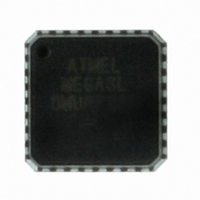ATMEGA8L-8MU Atmel, ATMEGA8L-8MU Datasheet - Page 171

ATMEGA8L-8MU
Manufacturer Part Number
ATMEGA8L-8MU
Description
IC AVR MCU 8K 8MHZ 3V 32-QFN
Manufacturer
Atmel
Series
AVR® ATmegar
Specifications of ATMEGA8L-8MU
Core Processor
AVR
Core Size
8-Bit
Speed
8MHz
Connectivity
I²C, SPI, UART/USART
Peripherals
Brown-out Detect/Reset, POR, PWM, WDT
Number Of I /o
23
Program Memory Size
8KB (4K x 16)
Program Memory Type
FLASH
Eeprom Size
512 x 8
Ram Size
1K x 8
Voltage - Supply (vcc/vdd)
2.7 V ~ 5.5 V
Data Converters
A/D 8x10b
Oscillator Type
Internal
Operating Temperature
-40°C ~ 85°C
Package / Case
32-VQFN Exposed Pad, 32-HVQFN, 32-SQFN, 32-DHVQFN
Package
32MLF EP
Device Core
AVR
Family Name
ATmega
Maximum Speed
8 MHz
Operating Supply Voltage
3.3|5 V
Data Bus Width
8 Bit
Number Of Programmable I/os
23
Interface Type
SPI/TWI/USART
On-chip Adc
8-chx10-bit
Number Of Timers
3
Controller Family/series
AVR MEGA
No. Of I/o's
23
Eeprom Memory Size
512Byte
Ram Memory Size
1KB
Cpu Speed
8MHz
Rohs Compliant
Yes
For Use With
ATSTK600-TQFP32 - STK600 SOCKET/ADAPTER 32-TQFPATSTK600-DIP40 - STK600 SOCKET/ADAPTER 40-PDIP770-1007 - ISP 4PORT ATMEL AVR MCU SPI/JTAGATAVRISP2 - PROGRAMMER AVR IN SYSTEMATSTK500 - PROGRAMMER AVR STARTER KIT
Lead Free Status / RoHS Status
Lead free / RoHS Compliant
Available stocks
Company
Part Number
Manufacturer
Quantity
Price
Part Number:
ATMEGA8L-8MU
Manufacturer:
AT
Quantity:
20 000
- Current page: 171 of 302
- Download datasheet (6Mb)
Transmission
Modes
Master Transmitter
Mode
2486Z–AVR–02/11
The TWI can operate in one of four major modes. These are named Master Transmitter (MT),
Master Receiver (MR), Slave Transmitter (ST) and Slave Receiver (SR). Several of these
modes can be used in the same application. As an example, the TWI can use MT mode to write
data into a TWI EEPROM, MR mode to read the data back from the EEPROM. If other masters
are present in the system, some of these might transmit data to the TWI, and then SR mode
would be used. It is the application software that decides which modes are legal.
The following sections describe each of these modes. Possible status codes are described
along with figures detailing data transmission in each of the modes. These figures contain the
following abbreviations:
S:
Rs:
R:
W:
A:
A:
Data: 8-bit data byte
P:
SLA: Slave Address
In
Flag is set. The numbers in the circles show the status code held in TWSR, with the prescaler
bits masked to zero. At these points, actions must be taken by the application to continue or
complete the TWI transfer. The TWI transfer is suspended until the TWINT Flag is cleared by
software.
When the TWINT Flag is set, the status code in TWSR is used to determine the appropriate soft-
ware action. For each status code, the required software action and details of the following serial
transfer are given in
are masked to zero in these tables.
In the Master Transmitter mode, a number of data bytes are transmitted to a Slave Receiver
(see
transmitted. The format of the following address packet determines whether Master Transmitter
or Master Receiver mode is to be entered. If SLA+W is transmitted, MT mode is entered, if
SLA+R is transmitted, MR mode is entered. All the status codes mentioned in this section
assume that the prescaler bits are zero or are masked to zero.
Figure 79 on page 174
Figure 78 on page
START condition
REPEATED START condition
Read bit (high level at SDA)
Write bit (low level at SDA)
Acknowledge bit (low level at SDA)
Not acknowledge bit (high level at SDA)
STOP condition
Table 66 on page 173
172). In order to enter a Master mode, a START condition must be
to
Figure 85 on page
to
Table 69 on page
183, circles are used to indicate that the TWINT
182. Note that the prescaler bits
ATmega8(L)
171
Related parts for ATMEGA8L-8MU
Image
Part Number
Description
Manufacturer
Datasheet
Request
R

Part Number:
Description:
8-bit AVR with 8K Bytes In-System Programmable Flash
Manufacturer:
ATMEL [ATMEL Corporation]
Datasheet:

Part Number:
Description:
IC AVR MCU 8K 8MHZ 3V 28DIP
Manufacturer:
Atmel
Datasheet:

Part Number:
Description:
IC AVR MCU 8K LV 8MHZ COM 32TQFP
Manufacturer:
Atmel
Datasheet:

Part Number:
Description:
IC AVR MCU 8K LV 8MHZ IND 32TQFP
Manufacturer:
Atmel
Datasheet:

Part Number:
Description:
IC AVR MCU 8K LV 8MHZ COM 28-DIP
Manufacturer:
Atmel
Datasheet:

Part Number:
Description:
IC AVR MCU 8K LV 8MHZ IND 28-DIP
Manufacturer:
Atmel
Datasheet:

Part Number:
Description:
IC AVR MCU 8K LV 8MHZ COM 32-QFN
Manufacturer:
Atmel
Datasheet:

Part Number:
Description:
IC AVR MCU 8K LV 8MHZ IND 32-QFN
Manufacturer:
Atmel
Datasheet:

Part Number:
Description:
MCU AVR 8KB FLASH 8MHZ 32TQFP
Manufacturer:
Atmel
Datasheet:

Part Number:
Description:
MCU AVR 8KB FLASH 8MHZ 32QFN
Manufacturer:
Atmel
Datasheet:

Part Number:
Description:
IC MCU AVR 8K 5V 8MHZ 32-TQFP
Manufacturer:
Atmel
Datasheet:

Part Number:
Description:
IC MCU AVR 8K 5V 8MHZ 32-QFN
Manufacturer:
Atmel
Datasheet:

Part Number:
Description:
IC MCU AVR 8K 5V 8MHZ 28-DIP
Manufacturer:
Atmel
Datasheet:












